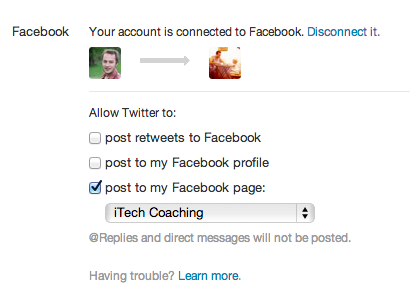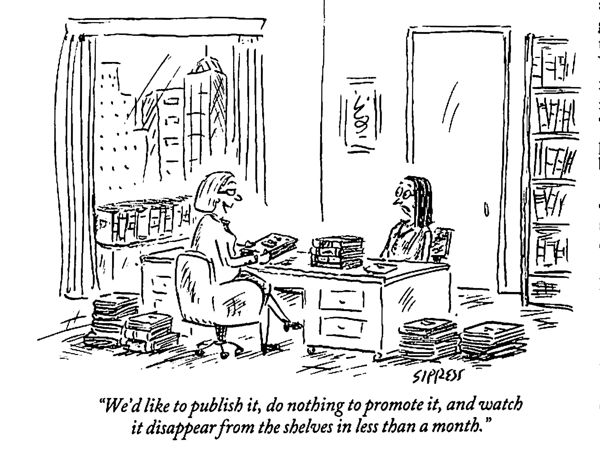So you’ve written a book. Congratulations! Whether you have a publisher or you’re self publishing, you’re going to need to promote your book. You might have a tour set up which is great but what about when you’re not touring? How do you reach people who want to read your book?
You might have a Facebook page or maybe a Twitter page but use it for more personal use, if at all. Or maybe you don’t have a Facebook or Twitter page. You’ve heard that you can use Facebook, Twitter and other social networks to help you with your business though don’t really know where to start.
This article will help you begin to break down the basics of starting a Facebook fan page, Twitter account and how to begin thinking of a strategy to start using them to connect with people who want to read what you’ve written and connect with you. If you don’t create a strategy in promoting through online social channels, your meeting with you publisher might sound something like this…
Ha! This ever consuming, fast past culture we live in is not slowing down anytime soon. Engaging with social media will extend the life of your book and give you insights and ideas that you might have never thought of. The bottom line is that if you invest some time and effort into wrapping your head around social media and the incredible value it provides, you’ll attract more customers, something you and your publisher will be happy about.
Check out these 7 tips on getting started with social media, geared especially towards authors who are reluctant to use social media.
1. Create a Facebook Fan page
This may be a no brainer to some but just to be clear, a fan page is different from a profile page. Your profile page is meant for your personal profile. A place where you post about personal things, maybe some business. A fan page is optimized to communicate, distribute information/content, engage fans, and capture new audiences virally through their fan’s recommendations to their friends. Here’s the page to get started on: www.facebook.com/pages/create
2. Create a Twitter page
Twitter is a powerful social network that you can use to share and connect with virtually anyone. It’s a different animal than Facebook though still, very powerful when understood and used properly. If you haven’t set up a Twitter account yet, do it now. www.twitter.com It’s easy, painless and you’ll see how many of your friends are already on it. Once you’re on Twitter, spend a little time filing out your profile, add a profile picture and come up with a short blurb about who you are, what you do or what you love. If you’re lost, check out other people’s profiles, maybe your friends and see how they define themselves.
3. Link your Facebook & Twitter pages
 By linking your Facebook and Twitter page, you take one step out of promoting. Though there are mixed reviews on this, I find that it creates visibility to your Facebook page and engages both networks at the same time. The way it works is when you post something on your Facebook page, it will show up on your Twitter stream. It does not work the other way around. Here’s how you set it up: Login to your Twitter account > Settings > Profile > Login to Facebook > Check the box that says Post to my Facebook page. Press Save at the bottom and you’re done.
By linking your Facebook and Twitter page, you take one step out of promoting. Though there are mixed reviews on this, I find that it creates visibility to your Facebook page and engages both networks at the same time. The way it works is when you post something on your Facebook page, it will show up on your Twitter stream. It does not work the other way around. Here’s how you set it up: Login to your Twitter account > Settings > Profile > Login to Facebook > Check the box that says Post to my Facebook page. Press Save at the bottom and you’re done.
4. Content Strategy
What is your book about? Spend some time dissecting what your book is about. Think about the main themes, content, messages etc. Are there any phrases or statements that would make great quotes? What type of person would resonate with this book? Are there other authors or groups that write or meet about the topics or subjects discussed in your book?
Start to think about breaking your book apart and how little phrases, ideas, anecdotes, quotes or thoughts might create conversations with people. Break these things into little chunks, ideally 140 characters or less to make them Twitter friendly. Think of it as a creative exercise that will engage potential readers about what you write about.
Break it up into categories and then sub categories. Make lists, preferably on your computer so it’s easy to transfer. Just jot down your ideas. Not to sound cliche but as Nike says, Just Do It!
5. How Often to Post
As mentioned earlier, Facebook and Twitter are different animals. It’s considered normal to post every hour or so on Twitter where as if you were to do that on Facebook, you’d very quickly annoy your fans and is frowned upon by Facebook. A tweet has the life span of about 30 seconds where as a Facebook post can last a day or so. In general, posting between 15 – 20 times a day on Twitter is a good habit to get into. For Facebook, posting more like 3 -5 is the amount to post so it shows up in people’s feeds.
This may sound daunting, especially if you’re just starting out. This is why creating a content strategy is key to your social success. Take a deep breath. Carve out a little time to start to wrap your head around this and create a strategy.
6. HootSuite and Facebook Scheduled Posts
![]() Now that your head is spinning, which I hope it’s not too much, thankfully, there are tools to help you manage your posting so you’re not spending all day on Facebook and Twitter trying to promote your book. HootSuite is a great resource for composing your tweets, retweeting other people’s news and having them all be spaced out throughout your day. It can also manage other Social Network accounts as well and really make your social experience a lot more manageable. HootSuite is a FREE tool and is well worth checking out. www.hootsuite.com
Now that your head is spinning, which I hope it’s not too much, thankfully, there are tools to help you manage your posting so you’re not spending all day on Facebook and Twitter trying to promote your book. HootSuite is a great resource for composing your tweets, retweeting other people’s news and having them all be spaced out throughout your day. It can also manage other Social Network accounts as well and really make your social experience a lot more manageable. HootSuite is a FREE tool and is well worth checking out. www.hootsuite.com
For example, lets say you have 6 things you want to share through Twitter. After you create a HootSuite account, login and post each one of those things and set a time that you want them to be posted throughout the day. Confused? Ok. Maybe this example will help. Think of posting your tweets on HootSuite like when you were in school and the school bell would ring. When the bell rings it would mean that it’s time to switch classes. Posting on HootSuite is like setting up the school bell the way you want it. On HootSuite, you choose the time you want the bells to ring, ie post your tweet. That way it will increase the likely hood that more people will see your tweet. (Maybe not the best analogy so hopefully this makes sense.)
You can also schedule your posts via Facebook. Check out this post for more details on that.
7. Have fun
 Most of all, this should be an enjoyable experience. Once you start dipping your toes in the water of social media, you’ll start to unlock some really cool and inspiring doors. There are people interested in what you’ve written about and want to read your book. Besides the publisher and the marketing team, if you’re fortunate enough to have this, harnessing the power of social media is a great way to reach potential readers. Even if you do have a publisher and marketing team behind your book, they’re still going to want you to use social media to help promote your book.
Most of all, this should be an enjoyable experience. Once you start dipping your toes in the water of social media, you’ll start to unlock some really cool and inspiring doors. There are people interested in what you’ve written about and want to read your book. Besides the publisher and the marketing team, if you’re fortunate enough to have this, harnessing the power of social media is a great way to reach potential readers. Even if you do have a publisher and marketing team behind your book, they’re still going to want you to use social media to help promote your book.
Please leave comments below if you have any questions or thoughts. This article is an overview of how to get started with social media for authors who are reluctant to embrace social media. If you’re interested in learning more about how to navigate the social media waters, please write me at the contact page.
Please sign the email list for tips and updates if you’re interested in more things along these lines.

